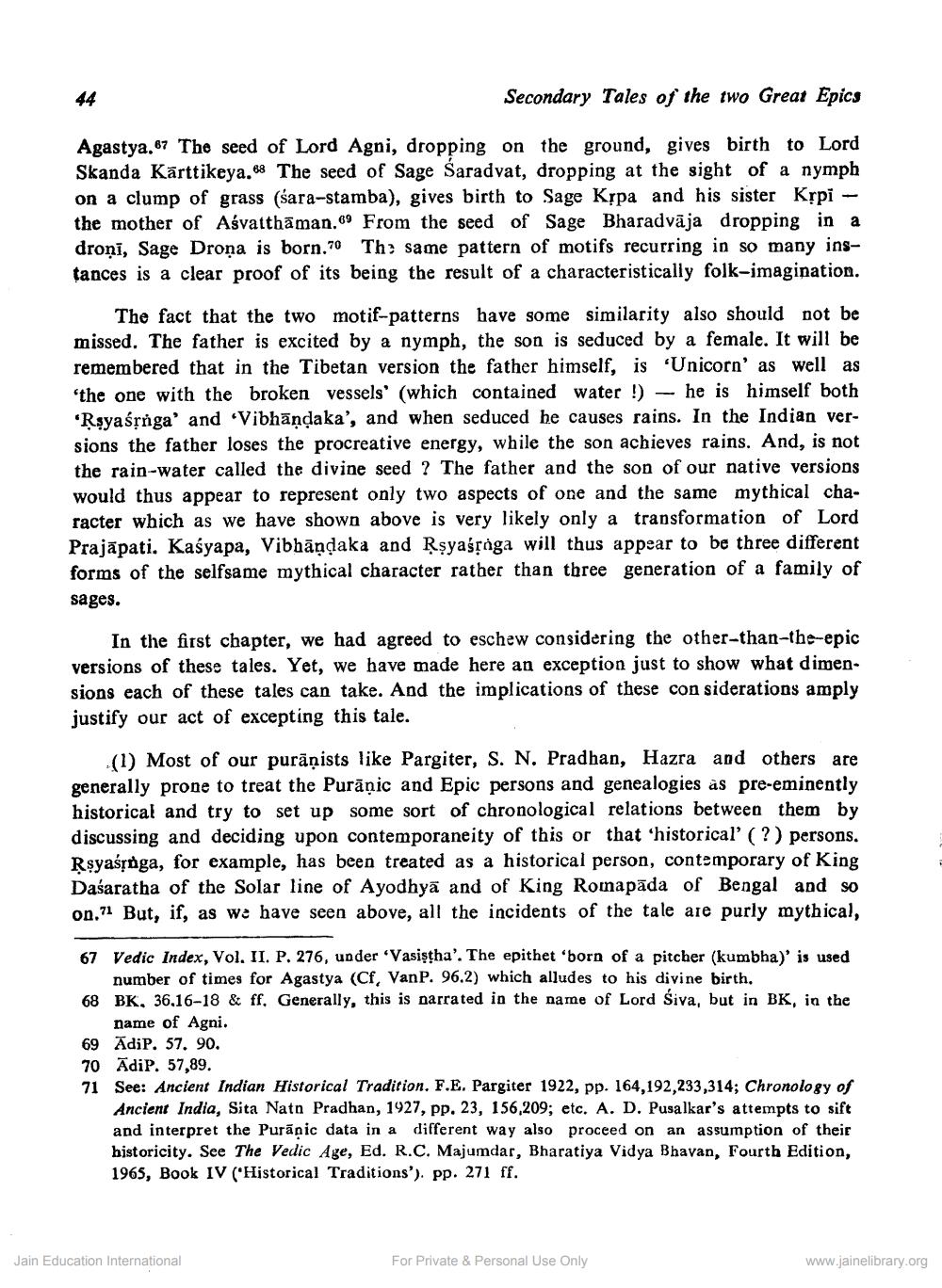________________
Secondary Tales of the two Great Epics
Agastya. The seed of Lord Agni, dropping on the ground, gives birth to Lord Skanda Kärttikeya." The seed of Sage Saradvat, dropping at the sight of a nymph on a clump of grass (sara-stamba), gives birth to Sage Krpa and his sister Krpi - the mother of Asvatthäman. From the seed of Sage Bharadvaja dropping in a droņi, Sage Drona is born.70 The same pattern of motifs recurring in so many instances is a clear proof of its being the result of a characteristically folk-imagination.
44
The fact that the two motif-patterns have some similarity also should not be missed. The father is excited by a nymph, the son is seduced by a female. It will be remembered that in the Tibetan version the father himself, is 'Unicorn' as well as 'the one with the broken vessels' (which contained water !) he is himself both 'Rayasraga and Vibhänḍaka', and when seduced he causes rains. In the Indian versions the father loses the procreative energy, while the son achieves rains. And, is not the rain-water called the divine seed? The father and the son of our native versions would thus appear to represent only two aspects of one and the same mythical character which as we have shown above is very likely only a transformation of Lord. Prajapati. Kasyapa, Vibhäṇḍaka and Rsyairaga will thus appear to be three different forms of the selfsame mythical character rather than three generation of a family of
sages.
In the first chapter, we had agreed to eschew considering the other-than-the-epic versions of these tales. Yet, we have made here an exception just to show what dimensions each of these tales can take. And the implications of these con siderations amply justify our act of excepting this tale.
(1) Most of our puräpists like Pargiter, S. N. Pradhan, Hazra and others are generally prone to treat the Puranic and Epic persons and genealogies as pre-eminently historical and try to set up some sort of chronological relations between them by discussing and deciding upon contemporaneity of this or that 'historical' (?) persons. Rsyanga, for example, has been treated as a historical person, contemporary of King Dasaratha of the Solar line of Ayodhya and of King Romapada of Bengal and so on." But, if, as we have seen above, all the incidents of the tale are purly mythical,
67 Vedic Index, Vol. II. P. 276, under 'Vasistha'. The epithet 'born of a pitcher (kumbha)' is used number of times for Agastya (Cf, VanP. 96.2) which alludes to his divine birth.
68 BK. 36.16-18 & ff. Generally, this is narrated in the name of Lord Siva, but in BK, in the name of Agni.
69 AdiP. 57. 90.
70 AdiP. 57,89.
71 See: Ancient Indian Historical Tradition. F.E. Pargiter 1922, pp. 164,192,233,314; Chronology of Ancient India, Sita Natn Pradhan, 1927, pp. 23, 156,209; etc. A. D. Pusalkar's attempts to sift and interpret the Puranic data in a different way also proceed on an assumption of their historicity. See The Vedic Age, Ed. R.C. Majumdar, Bharatiya Vidya Bhavan, Fourth Edition, 1965, Book IV (Historical Traditions'). pp. 271 ff.
Jain Education International
For Private & Personal Use Only
www.jainelibrary.org




